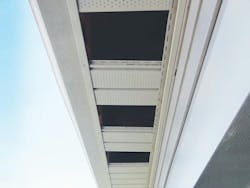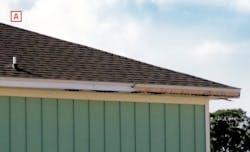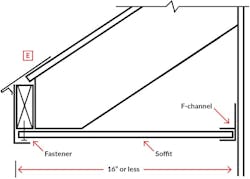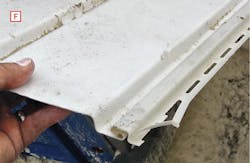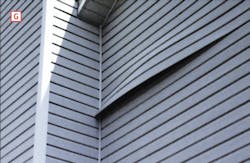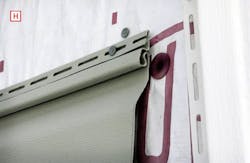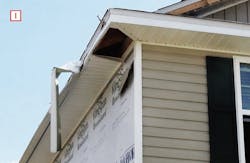I form part of an industry taskforce developing prescriptive codes for soffits and fascia. We aim to provide the Florida Building Commission with code language that will toughen one of the more common weak points in the building envelope during high-wind events. When soffits blow off, wind-driven rain penetrates the building and damages attic insulation, ceilings, and walls.
After Hurricanes Irma (Sept. 2017) and Michael (Oct. 2018), I toured the ravaged areas observing damage to soffits and fascia, trying to determine what may have caused the materials to fail and how to prevent it. For the most part, the failures resulted from incorrect specification of standard materials in high wind-velocity areas and incorrect material installation.
The most common pattern for soffit failure begins when wind tears the fascia off the building, exposing the soffit edge [A]. The wind then gets above the soffit and pries it loose from the sub-fascia, often stripping the panels completely off the building [B]. In other cases, wind directed upward by the sidewall pushes soffit panels up and out of the J-channel [C]. This often occurs when installers friction-fit the panels into J-channel. This is sometimes due to the practice of adapting J-channels by cutting tabs that enable wall fastening [D]. Research suggests that too many tabs spaced too close together can weaken the channel and lead to failure. A better option is to use F-channel, which is designed for the 90-degree connection [E].
How the Wind Damage Happens
Hurricanes, like earthquakes, place building components under unusual stresses, such as horizontal and ascending forces. Strategies that hold building components in place against gravity may not work to hold those components in place against hurricane-force winds.
In the case of vinyl soffits, the most common hurricane pattern is a sharp, horizontal wind that peels fascia off the eaves, then chisels into the soffit edge, left exposed by the missing fascia. The wind will skin soffit panels right off the building, opening a path for wind-driven rain to get inside. This effect is especially prevalent at building corners, where the geometry of the structure creates complex corkscrew patterns in the airstream.
In other instances, wind crashing against the windward side of the building turns upward and lifts soffit panels off their tracks along the wall―especially if the contractor friction-fit the panels into J-channel.
Improperly specified vinyl siding will fail in high-wind events, often because the nailing fin tears away from the fastener [F]. FEMA (Federal Emergency Management Agency) has noted that “unlatching [G], which is often the result of nailing hem failure, makes siding more vulnerable to tear-off, and that material with a doubled-over nailing fin [H] provides better resistance to tearing.” Corners are especially vulnerable to wind-damage, and two-story structures are more susceptible than a single-story structure. In this photo from the aftermath of Hurricane Michael [I], wind at the corner of the building peeled off the gutter and fascia, removed a soffit panel, and tore off the siding.
Why Codes Matter in Soffit, Siding Installation
In Florida, cladding materials, such as siding and roofing, must pass strict, state-specific testing before builders can use them in either standard (up to 130 mph) or high-velocity (up to 150 mph) wind zones. Because the trial includes material and installation specifications, Florida code prescribes that installers follow the manufacturer installation recommendations.
But who reads the installation instructions? Time after time, forensic inspection reveals that builders ignore manufacturer recommendations. The need for a uniform, easy-to-follow, and easy-to-inspect code has become evident to those of us that do the follow-up inspections. The IRC2018 specifies fasteners for vinyl siding [R703.3.3], and has prescriptive language for soffit installation that reads:
“Soffit panels shall be fastened at fascia and wall ends and to intermediate nailing strips as necessary to ensure that there is no unsupported span greater than 16 inches, or as specified by the manufacturer’s instructions.” [R703.3.1.2]
But the code still does not address fascia, which we found contributes to soffit failure. Our task force hopes to introduce robust language to future codes, treating the entire assembly, including the fascia and soffit panels, so that future storms do less damage. When the task force finishes its work, I will post our recommendations―there’s no reason to wait for the 2021 code to start building storm-resistant soffits.
Resources for Storm-Proofing Siding and Soffits
The Federal Emergency Management Agency (FEMA) and the Insurance Institute for Business & Home Safety (IBHS) have developed recommendations that you can refer to while waiting for codes to catch up.
FEMA P2023 Mitigation Assessment Report: Hurricane Irma in Florida
The contents of this 181-page report are aptly described in its subtitle: “Building Performance Observations, Recommendations, and Technical Guidance.” A section on soffit installation appears near the end.
Polymeric Siding Products Stand Up to the Storm
At vinylsiding.org, click on “Resources” tab in the main menu. This PDF contains reflections on Hurricane Irma from the Vinyl Siding Institute.
FORTIFIED vs. Common Residential Construction
At ibhs.org, click on “Risk Research” tab in the main menu. These dramatic videos feature two full-scale test houses built side-by-side to conventional code and FORTIFIED “code-plus” standards, then subjected to hurricane-force winds.
